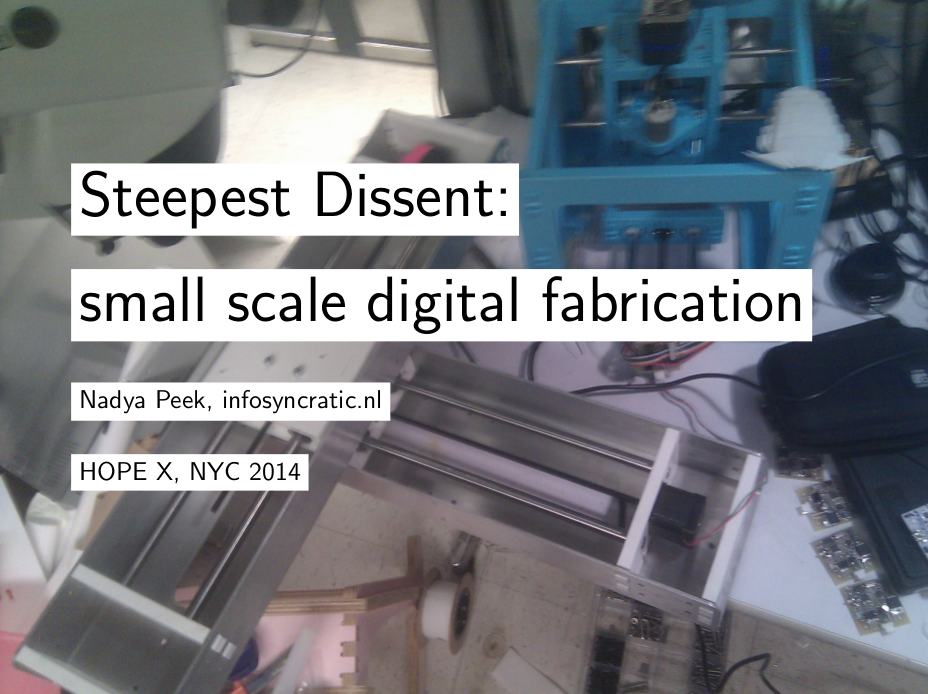Hackers On Planet Earth
July 31st, 2014Tags: fablab, hackercon, hackers, hope, hopex, hotel pennsylvania, nyc, oh lord lead us not into Penn station, steepest dissent
I went to HOPE X this year, the 10th Hackers On Planet Earth Conference organised by 2600, the hacker quarterly. It was in NYC next to Penn Station. I took the train. The train was great.
I gave a talk titled Steepest dissent: small-scale digital fabrication1, and the proposal I wrote was as follows:
Steepest dissent: small-scale digital fabrication
High precision in fabrication is often required for building useful hardware and tools- including hardware and tools that can be used for dissent. Craftsmanship is valued for its precision and attention to detail, but mastering a craft is inherently slow. 3D printers evoke a Star Trek replicator-esque hands-off solution for instantly creating precise tools, but in that image also become a transparent technology. However, digital fabrication techology as it exists today is anything but transparent, as digital fabrication tools are difficult to access, interface with, modify, and even use as intended. In a way, lack of access to precision fabrication is in itself a form of control.
Personal fabrication does hold the promise of making it easy for anyone to make anything to use anywhere. This personal fabrication would enable the production of tools and products for people who aren’t currently served by the selection available on the mass-market. However, actually making things and using them is tied up in a complicated ecosystem of materials, machine access, computer and design literacy, and distribution channels. High quality stock materials, export controls, and the ability to write machine control software all limit the possible outcomes from personal fabrication.
However, customised hardware at small scale is still being produced. Some by repurposing economies of scale, as found in e.g. grey market cell phone production, and some by leveraging the relative ease that digital fabrication equipment has brought to a field that previously required economies of scale, as found in e.g. diy hacker projects. In this talk I will explore some of both worlds, from the custom fabrication laboratories I inhabit at MIT to the shady foxconn-backyard electronics markets in Shenzhen. I hope these two worlds are on a collision course, and I’ll illustrate why I think some of the work I do on making-making-digital-fabrication-equipment-easier is facilitating this crash.
By the end of the talk I hope that hope x attendees will feel compelled to intervene in hardware and robotics technologies to more democratically represent the people on planet earth.

It might seem dramatic to speak of lack of access to precision as form of control– In the context of general-public access to digital fabrication (like in fab labs and maker spaces), research, projects, and work are often dismissed as a jejune engagement with “real” manufacturing, and that at some point makers graduate to “real” industry. Similarly, “citizen science” is often dismissed as an aspiration attempt to engage with “real” science, and “DIY bio” is dismissed as simple education experiments (learning about green fluorescence, amplifying DNA from your cheek) without any scientific impact.
But that is precisely the point– dismissing other voices in the arena of scientific knowledge production and technology development due to their development in “toy” labs and with “cute” machines is controlling. Constantly highlighting the (questionable, as aren’t we all just getting the job done) distinction between “industry” and “maker” means of production is controlling. Keeping the means of production separate from the means of consumption (e.g. not enabling users to write and compile ipad apps on ipads) is controlling.
These “toy” labs (hacker spaces etc.) are also meeting grounds for individuals who are interested in making things, who are interested in what other individuals are making, and who are interested in discussing what is being made. Impromptu open labs are spaces for dialogue, discourse, debate, and dreaming in science, culture, and technology.
For example, in Donetsk, Kostya Leonenko and friends founded a cultural platform called IZOLYATSIA. Eastern Ukraine was as they described to me not the area of Ukraine ripe with cultural engagement (in fact Sascha explained the MO to me as “get married have kids work in coal mine”). Creating a space with access to digital fabrication tools, with residencies and open spaces to enable exchange, and events to invite in community was a great act of dissent.
At the fablab and cultural space, Kostya and friends hosted programming workshops, open source hackathons, maintained 3d printers, a laser cutter, electronics equipment, and other digital fabrication tools. Then on June 9th, the lab was occupied by the Donetsk People’s Republic. The separatists apparently needed the space and its laser cutters for their activities.
There are other labs in areas of unrest, including Egypt and Northern Ireland. Perhaps they seem like educational play spaces for cultural exploration and not like traditional institutions of science and technology development. But I think we should all question those definitions.
Anyway, another thing I noticed at hope was that the HOPE X signs looked a lot like this Jean-Michel Jarre record I have. Apparently the original art is by Michel Granger.
There was also a screening of The Internet’s Own Boy, with Q&A with Noah after. If you haven’t seen it yet, try to find it:
Even though it’s mostly very sad.
Well, let’s all keep on hacking y’alls.
1. Next time I’m going to give this talk as “Steepest dissent: brewing unrest in a teacup” and have it be about how to find a cup of tea as quickly as possible by rolling downhill. Thanks to Matt for the banter. Also thanks to Jenn for encouraging me to go.<
